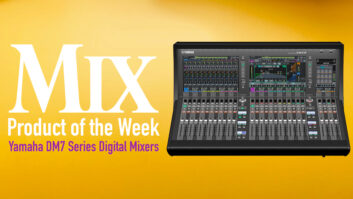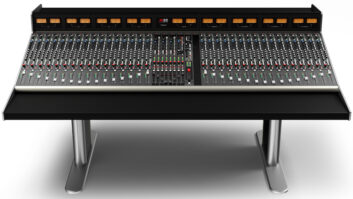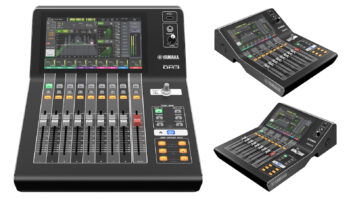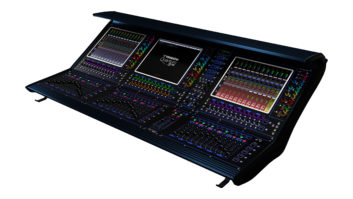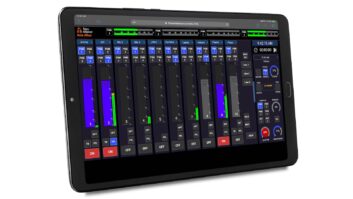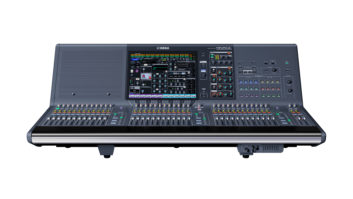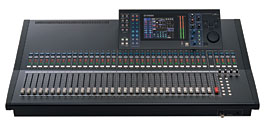

Since releasing the PM1D digital console eight years ago, Yamaha’s design engineers have become quite skilled at migrating advanced digital mixing technology to lower price points. On the heels of the PM1D came the hugely successful PM5D. More recently, Yamaha introduced the M7CL and the subject of this review, the LS9. Available in 16- or 32-channel configurations, the LS9 packs serious DSP power into a compact desk that can be easily transported by a single person.
QUICK AND INTUITIVE
My LS9-32 arrived literally hours before a series of local gigs with Wreckords Records artist Closenuf — just enough time to unpack it and give it a spin. Out of the box, the LS9 has I/O only on balanced XLRs: 32 inputs and 16 omni outputs. The input XLRs are self-explanatory. The output XLRs can be configured to serve as aux, group, matrix outs and main outs. At first sight, this was intimidating — I had visions of digging through menus just to learn how to assign the L/R master bus to two of these outs — but when I noticed that outs 15 and 16 were also labeled “L” and “R,” I opted to leave the manual in the box and go for the snoop approach: Turn it on and see what happens.
Within approximately 10 minutes of powering up, I was able to successfully do all of the following: connect the L/R master outs to a power amp, a Lab.Gruppen FP+10000; assign mix 1 to omni output 1 and mix 2 to omni output 2 for discrete monitor mixes; and assign rack 1 (a 31-band graphic EQ) to mix 1 and rack 2 (another 31-band graphic EQ) to mix 2 for monitor EQ. Within the same 10 minutes, I called up a great-sounding stereo reverb patch from the onboard effects library for use on send 13; recalled a mono delay from the library for use on send 14; edited that delay, named and stored it; tested all the inputs using a CD player; stored and named the console scene; and then left for the gig. The ability to do all this without cracking the manual is a tribute to Yamaha’s operating system and the LS9’s intuitive layout.
LEAVE THE RACK at HOME
Connecting a TRS line-level source to the LS9 requires either a direct box (in the case of the CD player, two Countryman Type 85s) or TRS-to-XLR adapters. For those in need of TRS I/O, the LS9’s rear panel has two mini-YGDAI expansion slots (the LS9-16 has one), which accept cards for additional analog I/O, as well as ADAT, TDIF or AES/EBU digital I/O, and CobraNet. I was initially concerned that I’d have a cable problem at the gig, but then I remembered that I wouldn’t need to bring my processing rack. The LS9’s onboard DSP provides compression, gating, 4-band EQ and highpass filter on every channel, plus a total of eight patchable effect “racks” that are user-assignable.
Each channel also features a 100mm motorized fader, 7-segment LED meter, and buttons for channel on, SEL and cue. The LS9-32 provides control over a maximum of 64 inputs on two 32-channel layers (32 inputs via the XLR ins and 32 more via expansion cards). Four dedicated buttons let you choose between the two input layers — a “master” layer and a custom layer — where you can mix and match any combination of input, output and matrix channels or mix masters. For example, if you want the star channel, two aux masters and a matrix master on one layer, you can have that.
NO TRS? NO PROBLEM!
Setup at the gig was a breeze. All I needed for patching was four XLR cables: two for the L/R bus and one each for the two monitor mixes. The band had a Shure wireless system, a bunch of wired mics and Dis for keys and bass, so the fact that I had no TRS I/O was no problem. Gain for the head amp is digitally controlled across a range that encompasses line- through mic level, negating the need for a mic/line switch. When you store a console scene, the gain is also stored. Occasionally, I could hear “stepping” while adjusting head-amp gain, which is not unheard of in digitally controlled analog preamps.
During the first show, I had no problem getting around the LS9. While mixing, I was able to quickly find the Preferences page where I could set the desk to auto-select, so that by touching a channel’s fader or button I could automatically select it for editing using the dedicated channel controls. These controls are found next to the color LCD and include head-amp gain, pan, selected send, dynamics 1 (threshold) and dynamics 2 (threshold), and a set of EQ controls. You can also view the desk’s parameters using the increment/decrement buttons, cursor and data wheel, all of which were easy to read, even in a club’s dim lighting.
To the left of the LCD are a series of lit push-buttons divided into two groups. One group provides access to mixes 1 through 16, while the other set is for global controls such as scene memory, monitor, setup, channel job, recorder, meter and racks 1 through 4 or 5 through 8. Thanks to these hot buttons, navigating the LS9 is very rapid. Once I had the mix up during the second show, I was able to name channels (kick, snare, etc.) and assign icons to each channel — the band really got a kick out of that. Ringing out the monitor wedges using the 31-band graphic EQs was facilitated by switching the EQ to Fader Assign mode, in which the faders function like the sliders on a graphic EQ — very slick and way more intuitive than using scrolling cursors and rotaries. Directly underneath the LCD are two extremely important controls labeled Cue Clear and Home. Home is invaluable: Any time I was into a deep menu, all I had to do was hit Home and the selected channel reappeared on the LCD. Cue Clear does exactly as it name implies, and is a control that every console needs.
Pressing any Mix button once tells the LS9 which send you want to address using the Selected Send rotary in the selected channel section. (This procedure isn’t as convoluted as it sounds.) If you press the Mix button a second time, then the desk enters Sends on Faders mode, in which the faders control send level. While this is happening, the LCD blinks “Sends on Fader” to remind you that the faders are changing aux levels, not level to the L/R bus. Because I had two monitor mixes running, I could toggle between the two and clearly see what faders were routed to which mix and then hit Home to jump back to the house mix. Monitor engineers will love this feature.
PLENTY OF DSP
As I expected, the LS9-32 is loaded with DSP, but unlike some of its competitors, the channels on the secondary layer (channels 33 to 64) are not crippled; you get exactly the same EQ, routing and dynamics capabilities on all 64 channels. Channel EQ is capable of subtle changes or serious “surgical” manipulation. When you are not on the Home screen, moving any of the selected channel knobs causes a pop-up window to appear that shows the value of that parameter. I found that when adjusting EQ, I could summon a shortcut to the EQ display that let me view the curve I was carving: Quickly press one of the EQ controls and then press Enter. (This works the same way for the threshold controls and the dynamics screen.) This works much faster during a show than using a cursor to navigate the screen to gain access to a particular processing section.
The dynamics capabilities should accommodate any application you might require. Dynamics 1 offers a choice of gate, ducking, compressor or expander, while dynamics 2 offers compressor, compander (hard), compander (soft) or de-esser. Compression can be set to run the range from subtle to completely squashing the audio signal. In one situation, when I mixed a dance-music diva with serious pipes, I used the EQ to pull out a bit of 3.5 kHz, as well as heavy compression to tame her peaks, which resulted in a smooth, musical vocal sound.
EXTRA, EXTRA
One of the LS9-32’s bonuses is a built-in USB recording/playback device. The USB port accepts a standard memory stick (up to 2 GB) and allows you to record the desk’s output to 96, 128 or 196kbps MP3 files. You can record audio from any bus on the console and route the player’s output either to a physical output or internally to two channels. The USB recorder can also play MP3s that are stored on the stick. MP3s may be linked to scenes so that when a scene is recalled, a specific MP3 plays automatically. (I admit that I had to read the manual to learn how to do this.) This feature will be a boon in theater applications.
Other features include assignable talkback, 12 user-defined function keys (I used two to bypass my main stereo effects) and the ability to link channels in nonstandard pairing. At one show, drum overheads were patched to channels 8 and 9. The LS9 can pair those channels, whereas many digital desks can pair either 7/8 or 9/10. Along with the 31-band graphic EQ, the LS9’s Flex15GEQ provides two linkable channels, where up to 15 of the traditional 31 graphic bands can be active, which is useful when mixing IEMs or stereo wedges.
A CLEAR WINNER
One of the LS9’s most important features is its sound — excellent. The audio paths are clean and have enough headroom to handle hot inputs, despite the absence of a dedicated mic/line switch, and the mix buses are as quiet as the day is long. In addition to the effects mentioned, you get chorus, flange, echo, tremolo and pitch shift of the Yamaha SPX nature that we all know and love. After using the LS9-32 for several weeks, it became apparent that this console is intuitive enough for less-experienced engineers and deep enough to perform some very serious routing assignments, including discrete L/C/R panning. Equally important, the operating system is rock-solid.
For many local gigs, I wrapped the LS9-32 in a blanket and transported it in the hatch of my Volkswagen Golf. It fit perfectly, and I was able to carry it solo. The power supply is built-in, as well as everything else you need for the “front end” of a very impressive P.A. system.
The LS9 brings big-ticket digital console operations down to earth, perfectly bridging the gap between consoles that aspire to a professional level and consoles that cost the same as a hot sports car. There isn’t much that the LS9 can’t do, and it’s likely to be a favorite among regional sound companies that want to take it up a notch. Prices: LS9-16, $5,999; and LS9-32, $10,999.
Yamaha, 714/522-9011, www.yamahaproaudio.com.

READ:
Yamaha LS9 Block Diagram
READ:
Yamaha LS9 Level Diagram
